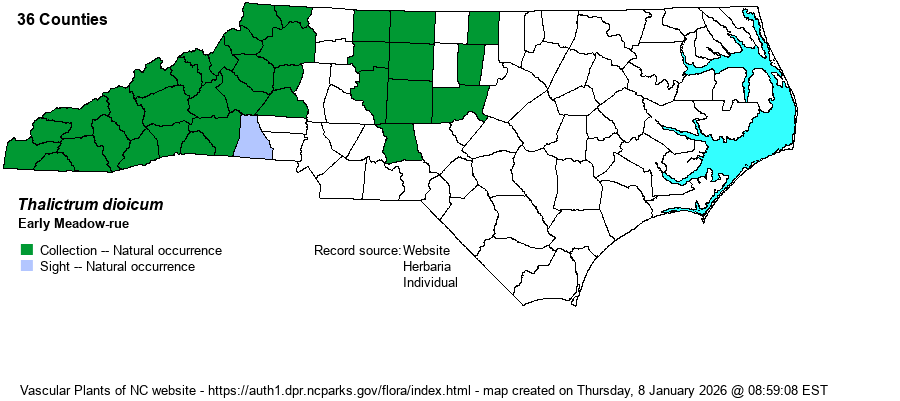| Author | L. | |
| Distribution | Throughout the Mountains; ranges eastward in the Piedmont into the central portions, at least to Person, Orange, Chatham, and Montgomery counties.
This is a Northern species, ranging across southeastern Canada and south to north-central GA, AR, and OK. | |
| Abundance | Frequent to common in the Mountains; uncommon in the Piedmont foothills, and rare to locally uncommon in the central portions. The NCNHP's State Rank of S3 is definitely too conservative, as it is a reasonably common species in NC; this website assigns a rank of S4. | |
| Habitat | This is a characteristic species of cool and moist forests, most often found in Rich Cove Forest, especially close to seepages and small creeks. It can be found in wet seepage slopes in Northern Hardwood Forests or other higher elevation forests. In the Piedmont, it is found mainly in Basic Mesic Forest natural community, as least in the central portions (found in richer and higher pH soils in this part of the state); but it can be found in various rich and moist forested sites in the foothills. | |
| Phenology | Blooms quite early, generally only in March and April, rarely into May; fruits shortly after flowering. | |
| Identification | This is a shorter Thalictrum species than the other erect ones -- discounting the very different T. thalictroides. The tip of the stem usually reaches only about 1-1.5 ffet high. Like others, the basal and stem leavers are doubly-ternately divided (with 3 sets of 3 leaflets per leaf). Each leaflet is about 1-1.5 inches long and wide, with three main lobes (the middle largest), but in this species and in T. coriaceum the lobes tend to have extra teeth on them as opposed to being smoothly rounded. Each leaf has a long petiole, often 2 inches long, including the leaf just below the base of the inflorescence; in T. coriaceum, this leaf is essentially sessile. This species has an open panicle of flowers, widely scattered and quite small, with no petals and caducous (dropping early) sepals. The species is dioecious, with male flowers on some plants and female flowers on others. The male flowers have white, filiform (needle-like) filaments, which are strongly drooping; the yellow anthers add a bit of color. Other than T. coriaceum, the other taller species in the genus have male flowers with broader filaments. This is the only species in the genus that you can normally spot in bloom in March and April, other than the very small T. thalictroides, which has often been placed in a different genus. Wildflower walks in the spring in cove forests often encounter this species, with the oddly "weeping" or "drooping" flowers. | |
| Taxonomic Comments | None
| |
| Other Common Name(s) | None | |
| State Rank | S3 [S4] | |
| Global Rank | G5 | |
| State Status | | |
| US Status | | |
| USACE-agcp | FAC link |
| USACE-emp | FAC link |

